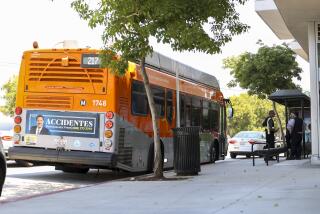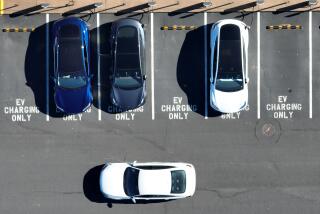Gore Offers $25 Billion for Energy Efficient Transit
CHICAGO — Cities that choose to establish more energy-efficient transportation methods stand to share up to $25 billion in federal grants and other incentives over the next decade under Vice President Al Gore’s energy plan.
Overlooking a sparkling Lake Michigan on Thursday, Gore announced the third and final portion of what has become a $148-billion “national energy security and environment trust fund.” The latest proposal would help cities pay for new rail systems and other mass-transit options to give Americans transportation choices and clean up the environment.
Gore has tossed out a host of energy-related campaign proposals this week to voters, from tax credits for purchasing hybrid gas-electric cars to financial perks for entrepreneurs who develop cutting-edge technologies to help steer the country away from “expensive, unreliable and distant” imported oil.
“I am proposing today that we do a lot more to help communities build and extend rail systems as they want to,” Gore told the friendly group of city leaders and activists, who cheered and whistled throughout the speech. “You won’t be forced to pay high gasoline prices; you will have a choice in how you will get around.”
Gore did not break down how the $25 billion would be spent in his “keep America moving” initiative, but he said he would provide grants for upgrading existing rail systems and subways, building high-speed rail systems in major transportation corridors and converting city and school bus fleets to cleaner-burning fuels.
Amtrak would receive funds to improve and expand existing passenger rail routes, and financial incentives would be available to help cities revitalize neighborhoods around transit stations.
The vice president vowed to give grants to communities that meet the transportation needs of residents in rural areas, and he cited a new light-rail system in Portland, Ore., as an example of ensuring mobility with “fewer arteries and more heart.”
“Real freedom is about having transportation choices,” said Gore, who acknowledged Americans’ love affair with their cars and stressed that he is not pushing them out of the driver’s seat and into mass transit.
Rather, the presumed Democratic nominee for president said: “You deserve the independence to get in your car and drive anywhere you want to go--without emptying your wallet at every filling station. You should also have the choice, if you want it, to park your car at a light-rail station and be moved swiftly into a newly thriving downtown.”
Gore has been promoting his energy plan during a “progress and prosperity” campaign tour designed to highlight the country’s booming economy and fat budget surplus. A cheerful Gore told reporters aboard Air Force Two on Wednesday that he has decided to extend the tour through next week, with stops in California, New York, Pennsylvania and Missouri. The three-week “progress” theme had been scheduled to end today.
“It is going so well that I will announce to you right now it is going to be extended for a fourth week,” Gore said, adding that he plans to take the Fourth of July off to celebrate the first birthday of his first grandchild, Wyatt. “I feel very good about the campaign. I feel very good. Something is happening out there. People want to see the prosperity and progress continue.”
Over the last three weeks, Gore has outlined how he would use the estimated $1.8-trillion budget surplus to build three so-called trust funds for education, health care and the environment. The country’s rosy economic forecast has forged an unprecedented type of battleground for the presidential election, one that focuses on where to put all of the money rather than where to find it.
In light of the summer’s soaring gasoline prices, Gore also renewed his call for the Federal Trade Commission to hold public hearings in its investigation into possible price gouging and collusion. If oil company executives are made to testify in the hearings, Gore said, “the people can hear . . . how they explain the coincidence of these sharp price increases beyond any explanation offered so far.”
More to Read
Get the L.A. Times Politics newsletter
Deeply reported insights into legislation, politics and policy from Sacramento, Washington and beyond. In your inbox three times per week.
You may occasionally receive promotional content from the Los Angeles Times.










